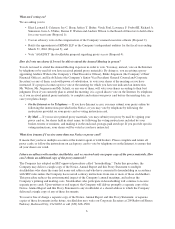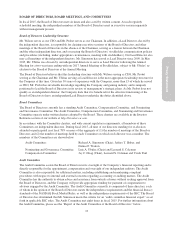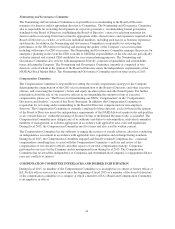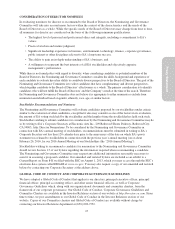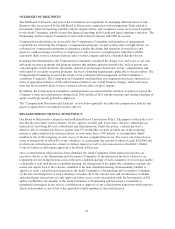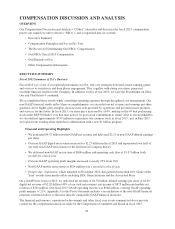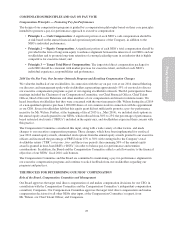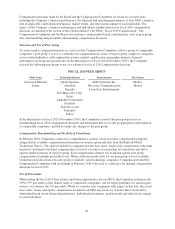Electronic Arts 2015 Annual Report Download - page 22
Download and view the complete annual report
Please find page 22 of the 2015 Electronic Arts annual report below. You can navigate through the pages in the report by either clicking on the pages listed below, or by using the keyword search tool below to find specific information within the annual report.OVERSIGHT OF RISK ISSUES
The full Board of Directors and each of the Committees are responsible for managing different forms of risk.
Business risks are reviewed by the full Board of Directors in conjunction with management. Risks related to
investments, financial reporting, internal controls and procedures, and compliance issues are reviewed regularly
by the Audit Committee, which oversees the financial reporting, global audit and legal compliance functions. The
Nominating and Governance Committee reviews risks related to director and CEO succession.
Compensation-related risks are reviewed by the Compensation Committee with members of management
responsible for structuring the Company’s compensation programs. As part of those risk oversight efforts, we
evaluated our compensation programs to determine whether the design and operation of our policies and
practices could encourage executives or employees to take excessive or inappropriate risks that would be
reasonably likely to have a material adverse effect on the Company and have concluded that they do not.
In making that determination, the Compensation Committee considered the design, size, and scope of our cash
and equity incentive programs and program features that mitigate against potential risks, such as payout caps,
cash and equity award clawbacks, the quality and mix of performance-based and “at risk” compensation, and,
with regard to our equity incentive programs, the stock ownership requirements applicable to our executives. The
Compensation Committee reviewed the results of our evaluation with management and the Committee’s
consultant, Compensia. The Compensation Committee concluded that our compensation policies and practices
strike an appropriate balance of risk and reward in relation to our overall business strategy, and do not create
risks that are reasonably likely to have a material adverse effect on the Company.
In addition, the Compensation Committee considered risks associated with the retention of employees given the
Company’s stock price performance during fiscal 2014 and fiscal 2015 and the structure and vesting schedules of
equity awards previously granted to employees.
The “Compensation Discussion and Analysis” section below generally describes the compensation policies and
practices applicable to our named executive officers.
RELATED PERSON TRANSACTIONS POLICY
Our Board of Directors has adopted a written Related Person Transactions Policy. The purpose of the policy is to
describe the procedures used to identify, review, approve or ratify and, if necessary, disclose “related-person
transactions” involving EA or its subsidiaries and related persons. Under this policy, a related person is a
director, officer, nominee for director, greater than 5% stockholder or entity in which any of the foregoing
persons is either employed in certain positions, or owns more than a 10% interest, or an immediate family
member of any of the foregoing, in each case as of the last completed fiscal year. We review any transaction or
series of transactions in which EA or any subsidiary is a participant, the amount of which exceeds $120,000 and
in which any related person has a direct or indirect interest as well as any transaction for which EA’s Global
Code of Conduct would require approval of the Board of Directors.
Once a related person transaction has been identified, the Audit Committee (if the transaction involves an
executive officer) or the Nominating and Governance Committee (if the transaction involves a director) are
responsible for reviewing the transaction at the next scheduled meeting of such committee. If it is not practicable
or desirable to wait until the next scheduled meeting, the chairperson of the applicable committee considers the
matter and reports back to the relevant committee at the next scheduled meeting. In determining whether to
approve or ratify a related person transaction, the Audit Committee or Nominating and Governance Committee
(or the relevant chairperson of such committee) considers all of the relevant facts and circumstances available
and related party transactions are only approved if they are in, or not inconsistent with, the best interests of EA
and its stockholders. No member of the Audit Committee or Nominating and Governance Committee is
permitted to participate in any review, consideration or approval of any related person transaction with respect to
which such member or any of his or her immediate family members is the related person.
16


